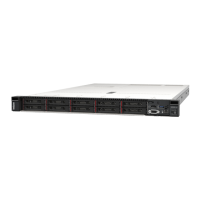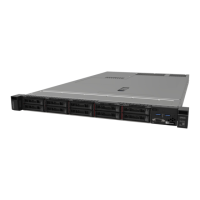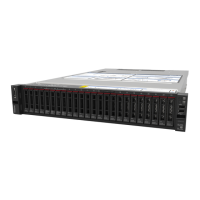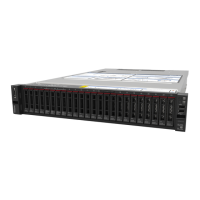Table 16. Components on the rear of the server (continued)
13 USB 3.2 Gen 1 (5Gbps) connectors (3 DCIs) 14 VGA connector
15 Ethernet connectors on rear OCP module 1 (optional)
Rear components overview
Ethernet connectors
Figure 8. OCP module (two connectors) Figure 9. OCP module (four connectors)
• The OCP module provides two or four extra Ethernet connectors for network connections.
• By default, any Ethernet connector on the OCP module can also function as a management connector
using the shared management capacity.
Notes:
• The server features three OCP slots: OCP 1 and OCP 2 are located on the rear side, and OCP 3 is
positioned at the front when the customer configures the front adapter assembly.
• OCP module 1 and front OCP module 3 are alternatives. When front OCP module 3 is configured, OCP
module 1 will be disabled.
• OCP module 1 and front OCP module 3 take priority over OCP module 2.
Hot-swap drives and drive bays
The drive bays on the front and rear of your server are designed for hot-swap drives. The number of the
installed drives in your server varies by model. When you install drives, follow the order of the drive bay
numbers.
The EMI integrity and cooling of the server are protected by having all drive bays occupied. Vacant drive
bays must be occupied by drive fillers.
PCIe slots
The PCIe slots are on the rear of the server and your server supports up to three PCIe slots on riser 1 and 2
assemblies.
Power supply units
The hot-swap redundant power supply helps you avoid significant interruption to the operation of the system
when a power supply fails. You can purchase a power supply option from Lenovo and install the power
supply to provide power redundancy without turning off the server.
On each power supply, there are three status LEDs near the power cord connector. For information about the
LEDs, see
“System LEDs and diagnostics display” on page 36.
USB 3.2 Gen 1 (5Gbps) connectors
The USB 3.2 Gen 1 (5Gbps) connectors are direct connect interfaces (DCIs) for debugging, which can be
used to attach a USB-compatible device, such as a USB keyboard, USB mouse, or USB storage device.
Chapter 2. Server components 27

